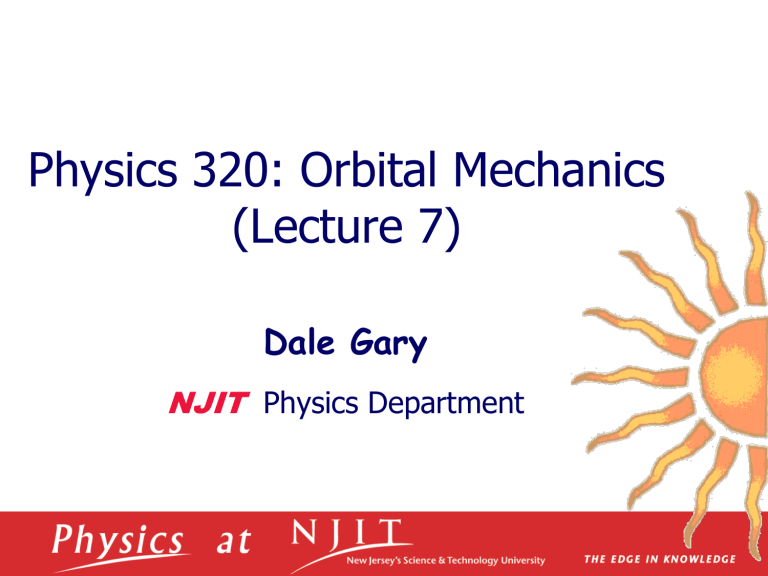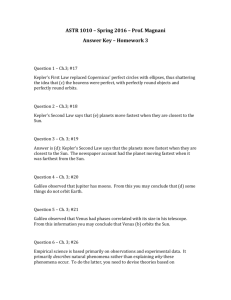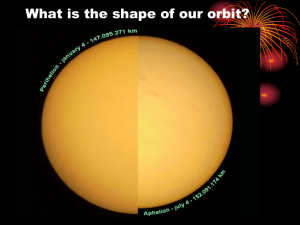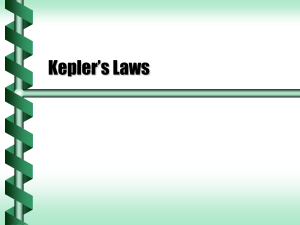
Physics 320: Orbital Mechanics (Lecture 7) Dale Gary NJIT Physics Department Reminder of Kepler’s Laws Kepler's Three Laws (quantitative version) First Law: Planets travel in elliptical orbits with the Sun at one focus, and obey the equation 𝑟 = 𝑐/(1 + 𝑒 cos 𝜃), where 𝑐 = 𝑎(1 − 𝑒 2 ) for 0 < e < 1. (Comets and other bodies can have hyperbolic orbits, where 𝑐 = 𝑎(𝑒 2 − 1), for e > 1.) Second Law: The radius vector of a planet sweeps out equal areas in equal times (planet travels fastest when near perihelion). Third Law: The square of the orbital period of a planet is proportional to the cube of its semi-major axis: 𝑃2 = 𝑘𝑎3, where k is a constant We also showed how Newton found the value of the constant 𝑘 = So 𝑃2 = 4𝜋2 3 𝑎 . 𝐺𝑀 Today, we will give a refinement of this result. September 25, 2018 4𝜋2 . 𝐺𝑀 Center of Mass Reference Frame We are now going to discuss the notion of center of mass, with which you are certainly already familiar. Think of a system of N particles a = 1, …, N, with masses ma and positions ra. The center of mass (or CM) is defined to 𝑁 N be the position m1r1 mN rN 1 where 𝑀 = 𝑚𝛼 R m r a a M a 1 M 𝛼=1 Like any vector equation, this represents separate equations for each of the components (X, Y, Z): 1 N 1 N 1 N X ma ya , Z ma za . ma xa , Y M M a 1 M a 1 a 1 You can think of the center of mass as a weighted average of the positions of each mass element, i.e. weighted by the mass of that element, or equivalently it is the vector sum of the ra, each multiplied by the fraction of mass at that location. To get a feeling for CM, let’s look at the center of mass for a two particle system, which might, for example, represent the Sun and Earth, or two stars in orbit around each other. September 25, 2018 Center of Mass and Equation of Motion 1 N m1r1 m2r2 In this case, R m r a a m m , which can be seen in theCMfigure. M a 1 1 2 m1 It is easy to show that the distance of the CM from m1 and m2 is in the ratio m2/m1. The figure shows the case r1 R where m1 4m2. In particular, if m1 >> m2, then the CM r2 will be very close to m1. m2 O Note that the time derivative of the center of mass for N particles is just the N N CM velocity 1 1 R ma ra pa Here I am using “dot-notation” 𝑑𝑟 M a 1 M a 1 for time derivative. = 𝑟 𝑑𝑡 . so the momentum of an N-particle system is related to its CM by P MR Differentiating this expression, we get the very useful relation for the Newton’s second law, the equation of motion of a system: Fext MR This says that the CM of a collection of particles moves as if the external forces on all of the individual particles were concentrated at the CM. This is why we can treat extended objects (e.g. a planet) as a point mass. September 25, 2018 Reduced Mass If we now move our coordinate system to the center of mass (i.e. set R = 0), 𝑚1 𝐫1 + 𝑚2 𝐫2 𝐑= =0 𝑚1 + 𝑚2 Then we can write r1 and r2 in terms of the vector r = r2 – r1 between the two masses: 𝑚2 𝐫1 = − 𝐫 𝑚1 + 𝑚2 𝐫2 = 𝑚1 𝐫 𝑚1 + 𝑚2 𝑚1 𝑚2 We now introduce the concept of reduced mass: 𝜇 = 𝑚1 + 𝑚2 so 𝐫1 = − 𝜇 𝐫 𝑚1 𝜇 𝐫2 = 𝐫 𝑚2 September 25, 2018 Reduced Mass and the CM Reference Frame When two objects of similar mass orbit each other, they both move around the common center of mass as in the figure below, left. We can reduce this complicated looking problem to an equivalent problem, where there is a single body of reduced mass m, orbiting a central body of mass M = m1 + m2, with a separation r = |r1- r2| . m1 r O 1 r2 CM r1 r2 m2 r = |r1- r2| m M O Arbitrary Origin atorigin CM Path relative to CM Equivalent one-dimensional problem Note, as 𝑚1 ∞, 𝜇 𝑚2 and the problem corresponds to a relatively small mass planet orbiting a massive star, as we have been implicitly assuming up to now. In many of our expressions from now on, we will be using reduced mass instead of the mass of one body, since it is more general. September 25, 2018 Kepler’s First Law Derived To derive the fact that a planet has to orbit in an ellipse, we have to begin with the orbital angular momentum (in the center of mass and using the reduced mass): 𝐋 = 𝐫 × 𝐩 = 𝐫 × 𝜇𝐯 An important fact about the gravitational force is that it is a central force, meaning it only acts radially, and cannot produce any change in angular momentum, i.e. 𝑑𝐋/𝑑𝑡 = 0. You can show this directly: vr and F p =are mvparallel, are parallel, so 𝑑𝐋 𝑑𝐫 𝑑𝐩 = ×𝐩+𝐫× =𝐯×𝐩+𝐫×𝐅 so cross product is thethe cross product is zero. 𝑑𝑡 𝑑𝑡 𝑑𝑡 zero. The text starts with the expression for angular momentum, and goes through a purely mathematical derivation of Kepler’s first law, which is not at all obvious and uses several obscure mathematical tricks. I encourage you to go through the steps, but we will not do so here. We just write the final result: The equation for an ellipse in terms of L, Kepler’s 1st Law 𝐿2 /𝜇2 𝑟= 𝐺𝑀(1 + 𝑒 cos 𝜃) 𝑎(1 − 𝑒 2 ) cf. our earlier polar equation for an ellipse 𝑟 = 1 + 𝑒 cos 𝜃 Note that this means 𝐿 = 𝜇 𝐺𝑀𝑎(1 − 𝑒 2 ) , which we will make use of later. September 25, 2018 Kepler’s 2nd Law Derived Kepler’s 2nd law, about the radius sweeping out equal areas in equal times, can be derived by considering the area swept. The radius sweeps out an area given by half of this rectangle, 1 or 𝑑𝐴 = 2 𝑟 2 𝑑𝜃. 𝑑𝐴 𝑑𝑡 1 2 𝑑𝜃 𝑟 𝑑𝑡 2 1 𝑟𝑣𝜃 . 2 Taking the derivative wrt time, But angular momentum is 𝐿 = 𝜇 𝐫 × 𝐯 = 𝜇𝑟𝑣𝜃 , so the rate of change of area can be expressed in terms of L = = dq r Sun 𝑑𝐴 𝐿 nd Law = Kepler’s 2 𝑑𝑡 2𝜇 So Kepler’s finding, that this rate of change of area is a constant, is merely an expression of the fact that the angular momentum is a constant. September 25, 2018 orbit Velocities in the Orbit At two particular locations in the orbit, namely perihelion (when the planet is closest to the Sun) and aphelion (when farthest from the Sun), there is no radial part of the velocity—the planet is moving only in the theta direction. At perihelion, 𝜃 = 0, so our earlier equation for the ellipse becomes, 𝐿2 /𝜇2 𝑟𝑝 = 𝐺𝑀(1 + 𝑒) But also here, the angular momentum is just 𝐿 = 𝜇𝑟𝑝 𝑣𝑝 , so (𝜇𝑟𝑝 𝑣𝑝 )2 /𝜇2 (𝑟𝑝 𝑣𝑝 )2 𝑟𝑝 = = 𝐺𝑀(1 + 𝑒) 𝐺𝑀(1 + 𝑒) A couple of lectures ago, we showed that 𝑟𝑝 = 𝑎(1 − 𝑒), so solving for 𝑣𝑝 , we have and likewise 𝑣𝑝 = 𝐺𝑀 1 + 𝑒 𝑎 1−𝑒 1/2 Perihelion speed 𝑣𝑎 = 𝐺𝑀 1 − 𝑒 𝑎 1+𝑒 1/2 Aphelion speed September 25, 2018 Kepler’s Third Law Derived Kepler’s third law can easily be obtained from his second law, by noting that the area swept out in a given time is constant, and the area swept out over one period is just the entire ellipse, which has an area 𝐴 = 𝜋𝑎𝑏. Thus, integrating the second law equation over an entire period, 𝐿 𝐿 𝐴= 𝑃= = 𝜋𝑎𝑏 2𝜇 2𝜇 So Kepler’s third law becomes 𝑃2 4𝜋 2 𝑎2 𝑏2 𝜇2 = 𝐿2 But we have an expression for b in terms of a, i.e., 𝑏2 = 𝑎2 (1 + 𝑒 2 ), and we also have our expression for L, which when squared is 𝐿2 = 𝜇2 𝐺𝑀𝑎(1 − 𝑒 2 ). Putting these both into the above, we have our final form of Kepler’s third law: 4𝜋 2 2 𝑃 = 𝑎3 Kepler’s 3rd Law 𝐺(𝑚2 + 𝑚1 ) September 25, 2018 Potential Energy We learned earlier that Newton’s law of universal gravitation provided the gravitational force equation: 𝑀𝑚 𝐅 = −𝐺 2 𝐫 𝑟 You may also recall that energy is force through a distance, and that potential energy is the negative of work done, i.e. 𝑟𝑓 𝑈𝑓 − 𝑈𝑖 = ∆𝑈 = − 𝐅 ∙ 𝑑𝐫 𝑟𝑖 Inserting the gravitational force into this equation (and being careful with signs!): 𝑟𝑓 𝑀𝑚 ∆𝑈 = 𝐺 2 𝑑𝑟 𝑟 𝑟𝑖 Evaluating the integral: 1 1 − 𝑟𝑓 𝑟𝑖 I stated earlier that we take the zero of potential energy at infinity, so we have the final result for any r: 𝑀𝑚 A massive object M creates a 𝑈 = −𝐺 gravity well around it 𝑟 𝑈𝑓 − 𝑈𝑖 = −𝐺𝑀𝑚 September 25, 2018 Escape Speed As a side note, since the potential energy at infinity is zero, an object falling from infinity will lose potential energy, which is everywhere negative inside the gravity well, and consequently the object will gain a kinetic energy given by the well-known K = ½ mv2. But it does this in such a way that its total energy remains zero! It simply converts its lost potential energy into kinetic energy, in exactly the same way that a ball dropped from a height on Earth does. Of course, it works the other way for an object moving outward. It will lose kinetic energy as it moves toward infinity (climbs out of the gravity well), and provided it has just enough energy to get to infinity, it will arrive there with 0 total energy. The speed that an object needs to go from some point in a gravity well (say, the surface of a planet) to infinity with zero energy is called the 1 𝑀𝑚 escape speed, derived from:𝐸 = 𝐾 + 𝑈 = 2 𝑚𝑣 2 − 𝐺 𝑟 = 0, so 𝑣esc = 2𝐺𝑀/𝑟 September 25, 2018 Orbital Energy It was mentioned a few lectures ago that any bound orbit has a total energy of less than 0. Let’s write the energy of a planet when it is at perihelion: 1 𝑀𝜇 𝐸 = 𝜇𝑣𝑝2 − 𝐺 2 𝑟𝑝 Using our values for perihelion distance and velocity: 𝐺𝑀 1 + 𝑒 𝑣𝑝 = 𝑟𝑝 = 𝑎(1 − 𝑒) 𝑎 1−𝑒 We have 1/2 1 𝑀1+𝑒 𝑀𝜇 1 𝑀 𝑀𝜇 𝜇𝐺 −𝐺 = 𝜇𝐺 𝑒 − 1 = −𝐺 2 𝑎 1−𝑒 𝑎 1−𝑒 2 𝑎 1−𝑒 2𝑎 If you calculate the same thing at aphelion, you will find the same expression. In fact, the energy is everywhere constant (and negative) over the orbit, and has this value: 𝑀𝜇 𝐸 = −𝐺 2𝑎 𝐸= September 25, 2018 Velocities in the Orbit Again Since the energy is everywhere constant, we can equate it to the kinetic plus potential energy at any point: 𝑀𝜇 1 2 𝑀𝜇 𝐸 = −𝐺 = 𝜇𝑣 − 𝐺 2𝑎 2 𝑟 We can then get a general expression for velocity in an orbit 2 1 = 𝐺(𝑚1 + 𝑚2 ) − 𝑟 𝑎 In the above, we have used the fact that M is the total mass of the system, M = m1 + m2. 𝑣2 This equation has a special name, the vis-viva equation. September 25, 2018 What We’ve Learned We learned that Kepler’s laws are just a consequence of the properties of a central force law, and that angular momentum is conserved in such a system. You should know that a star+planet system has a rather complex orbital relationship when the two masses are similar, but that this two-body system is 𝑚 𝑚 equivalent to a simpler system with a planet of reduced mass 𝜇 = 𝑚 1+𝑚2 1 2 orbiting a central object of mass 𝑀 = 𝑚1 + 𝑚2 ., at a distance 𝑟 = 𝑟1 + 𝑟2 , where r1 is the distance of m1 from the CM, and r2 is the distance of m2 from the CM. The equations governing Kepler’s three laws are: 𝐿2 /𝜇2 Kepler’s 1st Law (equation for an ellipse) 𝑟= 𝐺𝑀(1 + 𝑒 cos 𝜃) 𝑑𝐴 𝐿 Kepler’s 2nd Law (conservation of energy) = 𝑑𝑡 2𝜇 2 4𝜋 rd 𝑃2 = 𝑎3 Kepler’s 3 Law (period-distance law) 𝐺(𝑚2 + 𝑚1 ) 𝑀𝜇 We also have the orbital energy equation, 𝐸 = −𝐺 constant (and negative) 2𝑎 for any bound orbit. 2 1 We derived the useful equation for speed in an orbit 𝑣 2 = 𝐺(𝑚 + 𝑚 ) − 1 2 𝑟 𝑎 September 25, 2018



